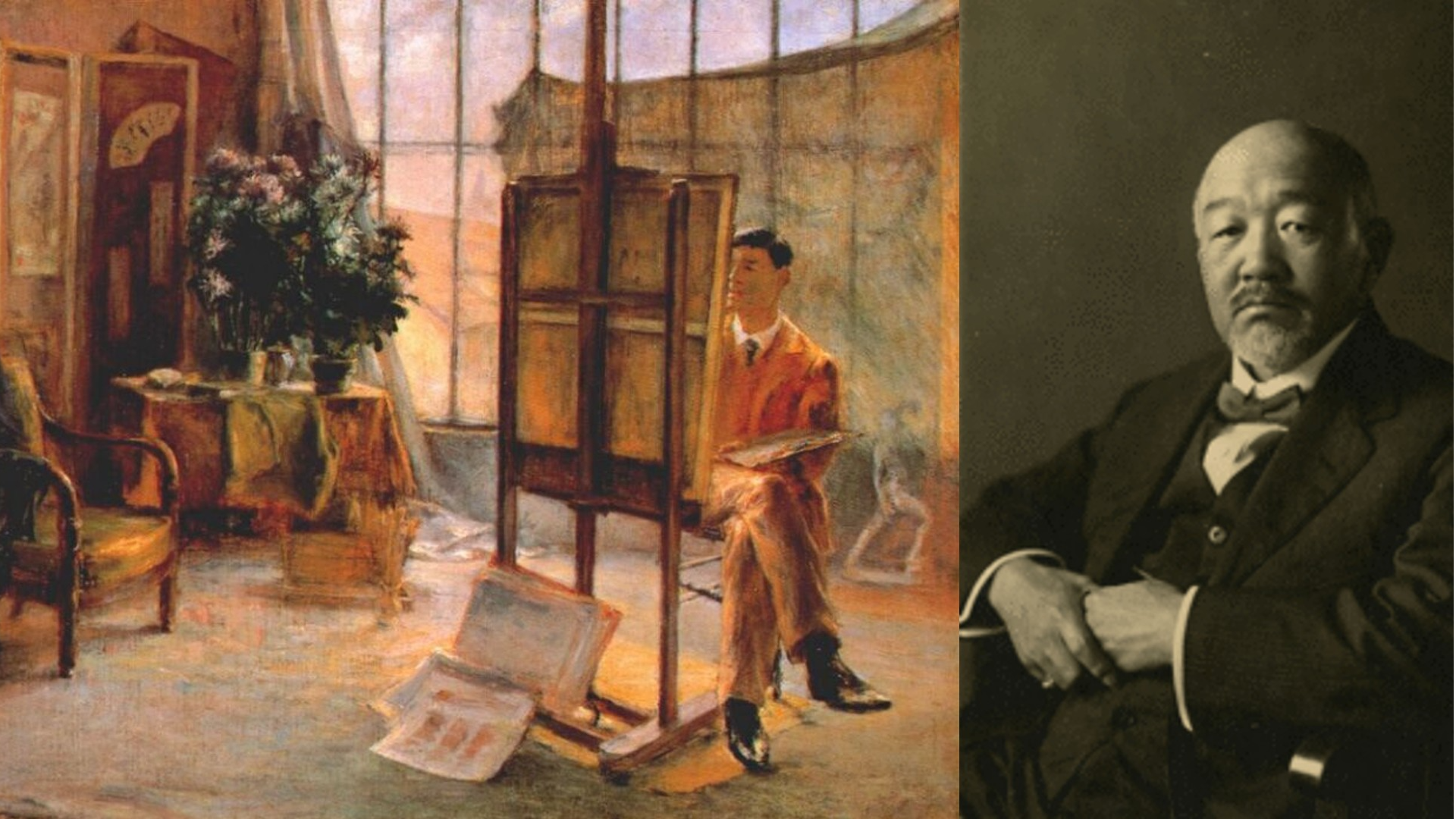Kuroda Seiki, born in 1866, was a notable Japanese artist and teacher who had a significant impact on the advancement of contemporary Western-style painting in Japan. He stood among the earliest Japanese artists to immerse himself in and excel at Western painting methods. with a focus on portraying everyday life, landscapes, and portraits in his art.
Early Life and Education of Kuroda Seiki:
Kuroda Seiki was born in Yokohama, Japan, during a period marked by Japan’s rapid modernization and Westernization. He displayed a keen interest in art from an early age and began his artistic journey by studying traditional Japanese painting. However, his passion for art eventually led him to seek further education in Europe.
In 1889, Kuroda Seiki embarked on a journey to France, where he enrolled at the prestigious École des Beaux-Arts in Paris. During his time in Paris, he fully immersed himself in the vibrant art scene and had the privilege of learning from renowned French painters like Raphaël Collin and Fernand Cormon. Additionally, he had the opportunity to explore major art exhibitions and museums, an experience that significantly shaped his artistic style.
The Impressionist Influence:
During his time in France, Kuroda Seiki was exposed to the works of Impressionist painters such as Claude Monet, Pierre-Auguste Renoir, and Edgar Degas. Their use of vibrant colors, loose brushwork, and emphasis on capturing fleeting moments greatly inspired him. Kuroda Seiki adopted some of these techniques and incorporated them into his own paintings.
Western Art Exposure Kuroda Seiki:
Kuroda Seiki was born in 1866 in what is now known as Okayama Prefecture, Japan. He was sent to study in France in 1886 by the Japanese government, where he was exposed to Western art for the first time. During his stay in France, he studied under the tutelage of famous painters such as Raphaël Collin and Benjamin Constant. He also visited museums and galleries to study the works of European masters such as Rembrandt, Rubens, and Delacroix.
Kuroda Seiki’s Encounter with Western Art:
Kuroda Seiki’s encounter with Western art had a profound impact on his artistic style. He was particularly drawn to the Impressionist movement and its emphasis on capturing the fleeting effects of light and color. He also admired the works of Realist painters such as Gustave Courbet and Jean-François Millet for their focus on everyday life and ordinary people.
Impact of Western Art Movements on His Work:
Kuroda Seiki’s exposure to Western art movements had a significant impact on his work. He is credited with introducing Impressionism to Japan through his paintings, which were characterized by their bright colors, loose brushwork, and emphasis on light and shadow. His works also reflected his interest in Realism, as he often depicted scenes from everyday life in Japan
The Meiji Era and Cultural Transformation:
Historical Context: The Meiji Restoration:
The Meiji Restoration was a turning point in Japanese history that led to the downfall of the shogunate and paved the way for major reforms. It brought about the modernization and Westernization of Japan, enabling it to become a significant international power.
Kuroda Seiki’s Role in the Meiji Era Art Scene:
Kuroda Seiki (1866-1924) was a prominent figure in the Meiji Era art scene. He is widely recognized as the “father of modern Japanese Western-style painting”. Kuroda Seiki’s artworks were characterized by their high artistic quality and painterly expression. His paintings, such as “Lakeside,” are considered iconic representations of elegant Meiji-era women. Kuroda Seiki’s contributions to Western-style painting reform during the mid-Meiji period were instrumental in shaping Japan’s art world.
Connection Between Art and Modernization:
Art played a significant role in Japan’s modernization process during the Meiji Era. Kuroda Seiki’s progressive artwork challenged societal norms and forced people to contemplate broader questions within the political backdrop of the Meiji Restoration. His integration of genres like nudes and plein-air art theories into art pedagogy influenced and informed the public. The reforms enacted during this era facilitated the development of a modern nation-state and laid the foundation for Japan’s emergence as a major international power.
Impact on Japanese Art with Kuroda Seiki:
Influence on Contemporary Artists:
Kuroda Seiki’s innovative approach to painting and his integration of Western techniques into traditional Japanese art have influenced numerous contemporary artists. His emphasis on capturing light, color, and everyday life has inspired generations of painters to explore new artistic possibilities.
Relevance of Kuroda Seiki Work in Modern Japan:
Kuroda Seiki’s work remains highly relevant in modern Japan. His paintings are celebrated for their artistic quality and their representation of an evolving Japan during a transformative period. They serve as a reminder of the cultural and artistic shifts that took place during the Meiji Era.
Kuroda Seiki’s Legacy in Japanese Art Institutions:
Kuroda Seiki’s legacy is preserved in various Japanese art institutions. His artworks are displayed in museums and galleries across the country, allowing visitors to appreciate his contributions to Japanese art history. These institutions play a crucial role in educating the public about Kuroda Seiki’s life, work, and his impact on the art world.
Kuroda Seiki’s Teaching and Mentorship
Viscount Kuroda Seiki (黒田 清輝) was a Japanese painter and teacher, known for bringing Western art theory and practice to a wide Japanese audience. He played a significant role in the yōga (or Western-style) movement in late 19th and early 20th-century Japanese painting. Kuroda Seiki is often referred to as “the father of Western-style painting” in Japan.
Contribution to Art Education
Kuroda Seiki made substantial contributions to art education in Japan. During his tenure as the director of the Tokyo School of Fine Arts, he had the opportunity to share his ideas with students eager to broaden their horizons. He encouraged his pupils to venture out of the studio, study anatomical drawing, and sketch life models as part of the curriculum.
Notable Students and Their Impact
Kuroda Seiki’s teachings left a lasting impact on his students, many of whom went on to become influential artists themselves. Some notable students include
- Yorozu Tetsugorō: A prominent figure in modern Japanese art, known for his unique style and exploration of various artistic techniques.
- Uemura Shōen: A renowned female painter who specialized in bijinga (pictures of beautiful women) and became the first woman to be awarded the Order of Culture.
- Kawabata Ryūshi: A landscape painter who played a pivotal role in the development of modern nihonga (Japanese-style painting).
Preservation of Kuroda Seiki Artistic Legacy:
Conservation Efforts:
Efforts have been made to conserve Kuroda Seiki’s artworks and ensure their longevity. Museums and galleries play a crucial role in preserving and showcasing his masterpieces. Some notable institutions dedicated to Kuroda Seiki include:
- Artizon Museum: Located in Tokyo, the Artizon Museum houses a collection of Kuroda Seiki’s works, allowing visitors to appreciate his artistic journey.
- Kuroda Memorial Hall: Situated within the Tokyo National Museum, the Kuroda Memorial Hall is another venue where visitors can explore Kuroda Seiki’s artistic achievements.
These museums and galleries provide an opportunity for art enthusiasts to delve into Kuroda Seiki’s artistic legacy and gain a deeper understanding of his contributions to Japanese art.
What is Kuroda Seiki best known for?
Kuroda Seiki (1866-1924) was a Japanese painter and teacher, who is known for bringing Western art theory and practice to a wide Japanese audience. He was among the leaders of the yōga (or Western-style) movement in late 19th and early 20th-century Japanese painting, and has come to be remembered in Japan as “the father of Western-style painting”.
How did Kuroda Seiki’s art change over time?
Kuroda’s art changed over time as he began to incorporate more elements of Japanese culture into his paintings. In particular, the “Academic Impressionism” style that Kuroda promoted. As exemplified in iconic paintings such as Lakeside (1897) and Lilies (1909). Achieved a long-lasting predominance within Japanese art society, forming the bedrock of modern. Western-style art training and practice in Japan for many decades to come.
What is the significance of his Western-style nudes?
Kuroda’s Western-style nudes were significant because they challenged traditional Japanese attitudes toward nudity and sexuality. His nudes were often depicted in natural settings. Which was a departure from the traditional Japanese style of depicting nudes in artificial or fantastical settings.
How did Kuroda Seiki contribute to modern Japanese art?
Kuroda contributed to modern Japanese art by promoting Western-style painting techniques and theories. He founded the Tenshin Dojo painting school, which helped to train many young artists in Western-style painting techniques. He also established pleinairism, which is an art-historical term used to describe painting outdoors and capturing nature.






Leave a Reply